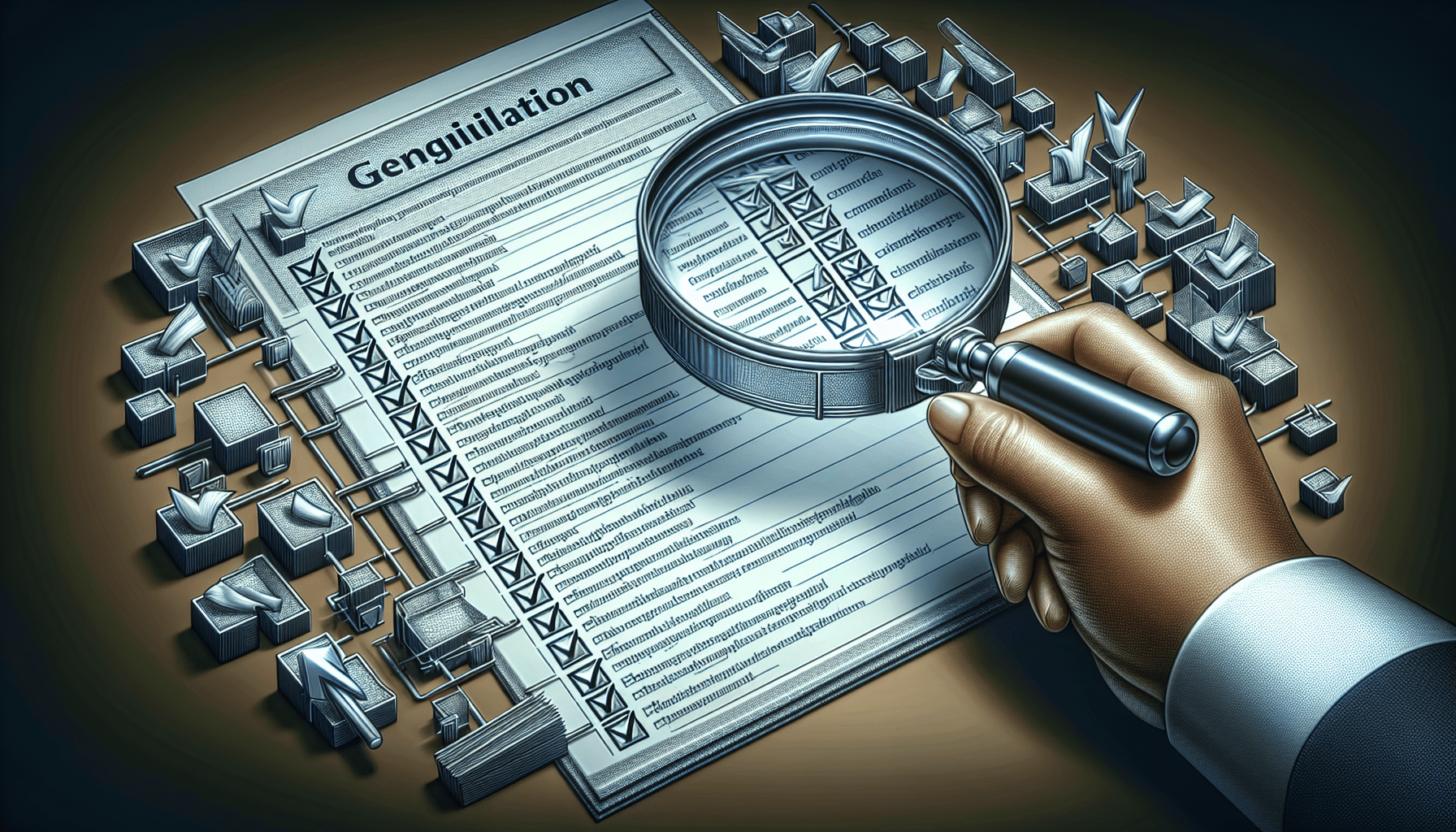In the business world, compliance with laws and regulations is crucial to maintain the integrity of an organization and avoid hefty penalties. Compliance audits serve as a vital tool to ensure that companies adhere to these requirements. In today’s article, we will explore the fundamental aspects of compliance audits, providing you with essential information that will help you understand their significance and navigate the complex landscape of regulatory compliance.

What is a compliance audit?
Definition
A compliance audit is a systematic and comprehensive examination of an organization’s policies, procedures, and processes to ensure they adhere to applicable laws, regulations, and industry best practices. It involves reviewing and evaluating the organization’s level of compliance with legal requirements and identifying any gaps or deficiencies that need to be addressed.
Purpose
The primary purpose of a compliance audit is to assess an organization’s adherence to regulatory requirements and internal policies to mitigate risks and ensure compliance. By conducting regular compliance audits, organizations can identify weaknesses in their processes, improve operational efficiency, and ensure legal compliance. The ultimate goal is to protect the organization’s reputation, avoid financial penalties, and prevent potential legal consequences.
Types of compliance audits
There are several types of compliance audits, each serving a specific purpose:
-
Financial Compliance Audits: These audits focus on ensuring an organization’s financial statements and accounting practices comply with relevant laws and regulations, such as the Sarbanes-Oxley Act (SOX).
-
Operational Compliance Audits: Operational compliance audits assess an organization’s adherence to internal policies and procedures, ensuring effective risk management, internal controls, and operational efficiency.
-
Privacy Compliance Audits: These audits examine an organization’s compliance with privacy regulations, such as the General Data Protection Regulation (GDPR), to protect personal data and ensure data privacy.
-
Health and Safety Compliance Audits: Health and safety compliance audits aim to verify compliance with regulations and procedures related to workplace safety, employee health, and environmental protection.
-
IT Compliance Audits: IT compliance audits assess an organization’s adherence to information security standards, software licensing, data protection, and other IT-related regulations.
Benefits of compliance audits
Identifying deficiencies
One of the key benefits of compliance audits is the identification of deficiencies in an organization’s policies, procedures, and processes. By thoroughly examining the organization’s compliance framework, auditors can pinpoint areas where improvements can be made, such as outdated policies, ineffective controls, or gaps in training programs. Identifying deficiencies early on allows organizations to take corrective actions and strengthen their compliance efforts.
Improving operational efficiency
Compliance audits also help organizations improve operational efficiency. By enforcing compliance with relevant laws, regulations, and internal policies, audits identify inefficient processes or redundancies that can be streamlined or eliminated. This leads to more streamlined operations, reduced costs, and increased productivity.
Ensuring legal compliance
Perhaps the most critical benefit of compliance audits is the assurance of legal compliance. Failing to comply with relevant regulations can result in severe legal consequences, financial penalties, and reputational damage. By conducting compliance audits, organizations can mitigate these risks, demonstrate their commitment to compliance, and avoid costly legal battles.
When are compliance audits necessary?
Changes in regulations
Compliance audits become necessary when there are significant changes in regulations that affect an organization’s operations. New laws or regulatory updates often require organizations to review their policies, procedures, and processes to ensure compliance. By conducting compliance audits during these transitional periods, businesses can quickly adapt to new requirements and maintain their legal standing.
Mergers and acquisitions
During mergers and acquisitions, it is crucial for organizations to assess the compliance practices of the entities being merged or acquired. Compliance audits help identify potential risks, liabilities, or non-compliance issues that could impact the success of the merger or acquisition. It allows organizations to make informed decisions, negotiate contracts effectively, and create strategies to address any compliance gaps.
Internal control evaluations
Regular internal control evaluations, including compliance audits, are necessary to ensure the effectiveness of an organization’s internal controls. Internal controls are designed to safeguard assets, prevent fraud, and ensure compliance with laws and regulations. Conducting compliance audits as part of internal control evaluations helps identify weaknesses or gaps in control measures and allows organizations to take corrective actions promptly.
Preparing for a compliance audit
Understanding regulatory requirements
To prepare for a compliance audit, organizations must have a sound understanding of the relevant regulatory requirements that apply to their industry and operations. This involves keeping up to date with changes in laws, regulations, and industry best practices. By staying informed, organizations can proactively adapt their compliance practices to meet evolving standards.
Establishing internal controls
Before undergoing a compliance audit, organizations should establish robust internal controls. Internal controls consist of policies and procedures that ensure compliance, mitigate risks, and safeguard assets. By implementing comprehensive internal controls, organizations can demonstrate their commitment to compliance and provide auditors with a framework to assess their processes accurately.
Documenting policies and procedures
One essential aspect of preparing for a compliance audit is documenting policies and procedures. Clear and well-documented policies help establish a standard framework for employees to follow, ensuring consistency and reducing the risk of non-compliance. By documenting policies and procedures, organizations can also provide auditors with tangible evidence of their commitment to compliance.

Conducting a compliance audit
Forming an audit team
The first step in conducting a compliance audit is forming an audit team. The team typically consists of individuals with expertise in relevant areas, such as legal, finance, operations, or information technology. Each team member brings valuable insights and ensures a comprehensive examination of the organization’s compliance practices.
Developing an audit plan
Once the audit team is established, they should develop an audit plan that outlines the scope, objectives, and methodologies of the audit. The plan serves as a roadmap and ensures that the audit is conducted in a structured and organized manner. It identifies key areas of focus, specifies the audit procedures to be followed, and sets a timeline for completion.
Gathering evidence
During the compliance audit, the audit team collects evidence to evaluate the organization’s compliance. This evidence may include internal documents, records, interviews with employees, and any other information deemed relevant. By gathering and analyzing this evidence, auditors can assess the organization’s level of compliance, identify potential gaps, and make recommendations for improvements.
Common compliance audit findings
Inadequate recordkeeping
One common finding in compliance audits is inadequate recordkeeping. Poor recordkeeping practices not only indicate potential non-compliance but also hinder the ability to demonstrate compliance during an audit. Auditors often look for missing or inaccurate documentation, incomplete records, or a lack of proper documentation review and retention policies.
Lack of employee training
Another common finding is a lack of employee training. Organizations must provide comprehensive training programs to ensure that employees are aware of relevant laws, regulations, and internal policies. Failure to provide adequate training increases the risk of non-compliance and can lead to severe consequences during a compliance audit.
Non-compliance with privacy regulations
Given the increasing importance of data privacy, non-compliance with privacy regulations is a significant finding in compliance audits. Auditors scrutinize organizations’ data protection practices, consent mechanisms, privacy policies, and data breach response procedures. Non-compliance with privacy regulations can result in substantial penalties and reputational damage.
Addressing compliance audit findings
Implementing corrective actions
Addressing compliance audit findings requires implementing corrective actions to rectify any identified gaps or deficiencies. This may involve updating policies, improving recordkeeping practices, enhancing training programs, or implementing new controls. It is crucial to develop an action plan that outlines specific steps, assigns responsibilities, and establishes timelines to ensure the prompt resolution of audit findings.
Updating policies and procedures
To address compliance audit findings, organizations should update their policies and procedures as necessary. This may involve revising existing policies or creating new ones to align with the latest regulations and industry best practices. Regularly reviewing and updating policies and procedures ensures ongoing compliance and demonstrates a commitment to adapt to changing requirements.
Providing additional training
If the compliance audit reveals a lack of employee training, providing additional training becomes a priority. Organizations must invest in comprehensive training programs that educate employees on relevant laws, regulations, and internal policies. By equipping employees with the knowledge and skills needed to comply with requirements, organizations can mitigate the risk of non-compliance and foster a culture of compliance within the organization.
Consequences of non-compliance
Financial penalties
Non-compliance with regulatory requirements can result in significant financial penalties. Regulatory bodies have the authority to impose fines and monetary sanctions on organizations that fail to comply with relevant laws. These penalties can range from minor monetary fines to substantial amounts that can severely impact an organization’s financial stability.
Reputational damage
Non-compliance can cause lasting damage to an organization’s reputation. Negative publicity, loss of customer trust, and damage to brand image are common consequences of non-compliance. Rebuilding a damaged reputation can be a costly and time-consuming process, often requiring extensive marketing efforts and public relations campaigns.
Legal consequences
In addition to financial penalties and reputational damage, non-compliance can lead to legal consequences. Organizations may face lawsuits, litigation, and regulatory investigations, resulting in even more significant financial burdens. Legal consequences can include loss of licenses or permits, temporary or permanent closure of operations, and even criminal charges for individuals involved in non-compliant activities.
The role of technology in compliance audits
Automation of audit processes
Technology plays a crucial role in streamlining compliance audits through the automation of audit processes. Audit management software allows organizations to efficiently plan, schedule, and execute audits, reducing reliance on manual and time-consuming tasks. Automation also improves data accuracy, simplifies report generation, and enables real-time monitoring of compliance efforts.
Data analytics
Data analytics tools enable auditors to analyze large amounts of data quickly and effectively, providing insights into compliance patterns and anomalies. By leveraging data analytics, auditors can identify potential risks, pinpoint non-compliance issues, and detect fraudulent activities. This technology helps auditors focus their efforts on areas of highest risk and enhances the effectiveness of compliance audits.
Continuous monitoring
Technology also enables organizations to implement continuous monitoring of compliance efforts. Through the use of monitoring software and automated systems, organizations can continuously track and monitor their compliance activities in real-time. This proactive approach allows for immediate identification of non-compliance issues, enabling prompt corrective actions and reducing the risk of prolonged non-compliance.
Best practices for successful compliance audits
Engaging with external auditors
Engaging with external auditors is a best practice in conducting successful compliance audits. External auditors provide an unbiased perspective and bring their expertise and experience to the audit process. By involving external auditors, organizations can ensure a thorough and independent examination of their compliance practices.
Regular internal audits
In addition to compliance audits conducted by external auditors, regular internal audits are essential for maintaining ongoing compliance. Internal audits should be conducted at predetermined intervals to assess the effectiveness of internal controls, verify compliance with policies and regulations, and identify any emerging risks or deficiencies. Regular internal audits help organizations stay proactive in their compliance efforts.
Ongoing compliance monitoring
Compliance should not be seen as a one-time activity but as an ongoing process. Establishing a system for ongoing compliance monitoring helps organizations stay up to date with changing regulations, identify potential risks, and address non-compliance issues promptly. Ongoing monitoring demonstrates a commitment to maintaining compliance and reduces the likelihood of major compliance gaps.
In conclusion, compliance audits play a vital role in ensuring organizations adhere to applicable laws, regulations, and internal policies. By identifying deficiencies, improving operational efficiency, and ensuring legal compliance, compliance audits help organizations mitigate risks, avoid financial penalties, and protect their reputation. By understanding when compliance audits are necessary, preparing adequately, addressing findings, and utilizing technology, organizations can navigate the complex landscape of compliance and achieve successful compliance audits. Employing best practices such as engaging with external auditors, conducting regular internal audits, and implementing ongoing compliance monitoring further strengthens an organization’s commitment to compliance and enhances its overall compliance efforts.



